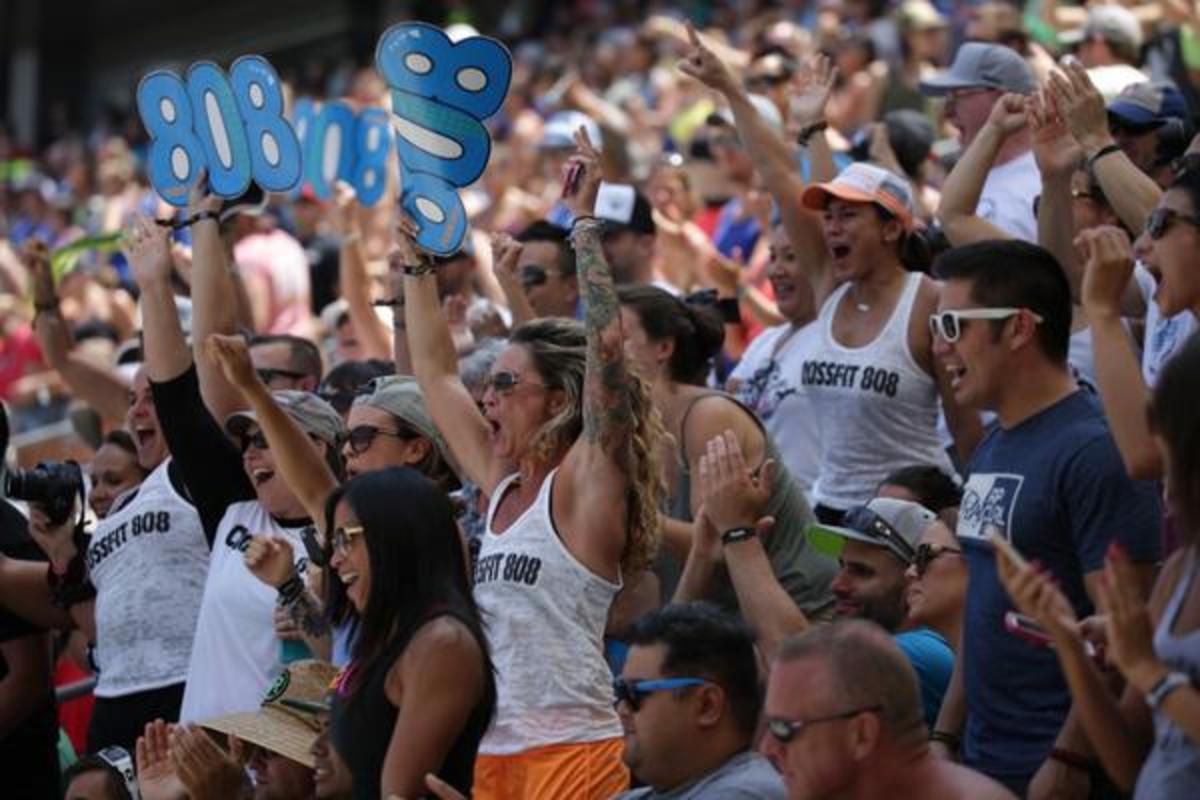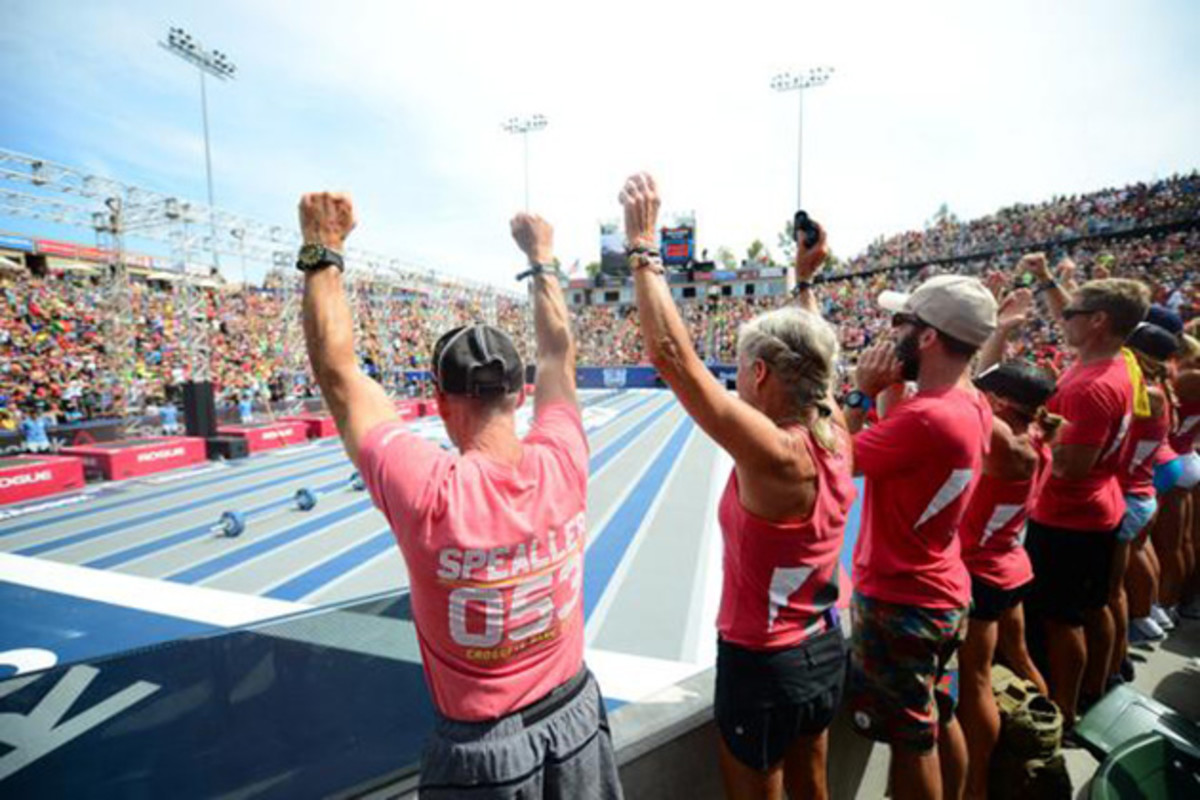For the love of CrossFit: Everyone's all in it together at the Games

There’s a strange phenomenon that occurs at the CrossFit Games, which concluded Sunday at the StubHub Center in Carson, Calif. Unlike at other sporting events, where often it seems that half the crowd is spewing vitriol, there is no negativity. No one is booed. No ill will wished. The biggest cheer of the day always comes for the athlete in last place as he or she struggles to complete a workout. Even heated rivals, upon finishing an event, pull themselves off the turf to shout encouragement to their competitors finishing behind them.
In CrossFit everyone is the home team.
“We cheer from first to last,” says Ki Kim, a fan with front row seats and a member of East Valley CrossFit in Chandler, Ariz. “We want to encourage them to make sure everyone finishes. We’ve all been first. We’ve all been last ourselves.”
Case in point: There were two standing ovations from the capacity crowd in the StubHub Center tennis stadium surrounding the second-to-last event of the Games, a combination of rope climbs and overhead squats called Thick ’N Quick. One was for Rich Froning, as he powered through the workout in 1:40, 20 seconds faster than anyone else, on the way to winning his fourth-straight title of Fittest Man on Earth. The other ovation was for a non-competitor named Wes who demonstrated the workout before it was contested. Wes struggled with the squats, dropping the bar several times. The crowd rose to its feet as he battled through wobbling legs to complete his final rep, a solid ten minutes after he’d started it.
Nearly everyone in the arena is a CrossFitter. This is apparent from the two choices of garb among fans: a branded T-shirt representing a local CrossFit affiliate or no shirt at all to display the rippling muscles earned at said local affiliate. Vendors sell huge chunks of grilled meat to appeal to the paleo diet many CrossFitters follow. It’s a shame ComicCon is held the same weekend in San Diego, since everyone with the physique of a superhero seems to have gathered 100 miles to the north.
Community. #CrossFit pic.twitter.com/XBfrJcr2Fy
— CrossFit (@CrossFit) July 27, 2014
The fans treat competitors less with distanced adoration than knowing admiration. Sports fans are always saying things like, “Even I could have scored on that play.” There’s none of that here. The crowd knows for a fact that they couldn’t have.
“Everybody understands what we do,” says Froning. “You can actually do the same events we did and know how that feels. I think that’s what makes this so cool and what makes it so spectator-friendly. People know what we’re going through. They know the misery, the pain.”
The CrossFit Games may be the most egalitarian sporting event on the planet. Anyone, as long as he or she has the $5 entry fee and the means to submit results, can attempt the qualifying workouts for the big event. More than 209,000 people worldwide did just that in 2014. By Sunday afternoon, after 12 grueling workouts over four days in the brutal California heat, and with the field narrowed down to 10 men and women for the final heat of final event, the crowd knew exactly how difficult the journey to the finals had been, because a huge number had attempted it themselves.

This is a sporting community that’s just different. The question, “Who do you want to win?” is met with a knowing gaze that says “You’re not from around these parts, are you?” Victory is not what CrossFit is really about. Participation and effort are paramount. Imagine a Super Bowl MVP telling reporters at the post-game press conference that the title game isn’t what matters, that it’s practice that is the true core of football. That’s exactly the message spread by Froning and the second- and third-place men’s finishers, Mathew Fraser and Jason Khalipa.
“CrossFit is not the CrossFit Games,” says Khalipa, who won the 2008 title. “The CrossFit Games is one expression of what CrossFit is. Don’t get wrapped up in the Games, get wrapped in [the workouts] and over time, you’ll start understanding more about CrossFit and hopefully get here.”
Another element that differentiates the CrossFit Games is its equitable celebration of both sexes. The women do the exact same workouts as the men, with scaled down weight. They earn identical prize money, $275,000 each for Froning and women’s champion Camille Leblanc-Bazinet. Female competitors are some of the sport’s biggest stars. This is reflected in local gyms as well, where an estimated 60 percent of CrossFit customers are women.
“It’s always bothered me a little bit in some sports that men and women can never really go against each other,” says 2014 runner-up and two-time champion Annie Thorisdottir.
Everyone involved—fans, competitors, organizers—seems to be primarily concerned with benefitting CrossFit as a whole. When immersed in the sea of chiseled abs and overwhelming positivity at the CrossFit Games, it’s easy to understand how the sport has grown from just 70 athletes and $500 in prize money in 2007 to hundreds of thousands of entrants vying for a total purse of $1.75 million this year.

This is not to say that CrossFit’s future growth is entirely unencumbered. It will always be a challenge to draw in spectators to the Games who are not active in the community themselves. With expansion comes skepticism, as well. There has been increasing scrutiny of the alleged dangers of the CrossFit workout program, which has led to a forthcoming legal battle.
CrossFit is also no longer the only game in town in the fitness-as-sport world. August will see the launch of the National Pro Grid League, a team-based league founded by former CrossFit executive Tony Budding. There may be space for the NPGL to steal some of CrossFit’s audience, as team competition has always taken a back seat to individual at the Games.
That space appears to have closed, however, with both Froning and Khalipa announcing that they will retire from individual competition and form teams for the 2015 Games. Their decisions, at least in part, are fueled by the desire to raise their sport’s profile across the board.
“Now that we have established stars like these guys, once they start going to team, it’s going to draw a lot more eyeballs,” says Games director Dave Castro.
These concerns are unspoken at the StubHub Center. Whatever the level of skepticism outside the arena, the folks on the inside have drunk the Kool-Aid (though none of them would actually ever consume a sugary drink like Kool-Aid).
Despite the expanding audience and ballooning prize money, the message remains clear: The CrossFit Games are merely the most visible tip of a very large spear. It’s an ethos that Khalipa distills to its essence when asked how fans can persuade friends to watch the Games.
“Watch?” he says, shaking his head. “No. Do.”
